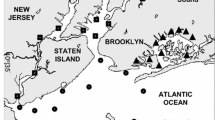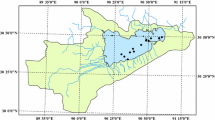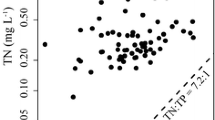Abstract
Light conditions in laboratory scale enclosures (LSE) of shallow, eutrophic Lake Loosdrecht (The Netherlands), including a method for simulating a ‘natural’ incident light course, are described. Total PAR (400–700 nm) and spectral irradiance distribution were measured at sestonic chlorophyll a and dry weight concentrations ≥ 100 mg m−3 and 16 g m−3, respectively. Phytoplankton was dominated by Oscillatoria spp. The euphotic depth (Z eu) was 0.7–1.0 m. Shortly after filling the LSE with lake water, diffuse attenuation coefficients ranged from 14 m−1 for blue to 5 m−1 for red light. Around Z eu, attenuation in the blue region was markedly lower and irradiance reflectance (R) continued to increase; these anomalies were caused by lateral incident light from the LSE's waterbath. Spectrophotometry indicated that absorption was mainly by particles, but dissolved humic substances (gilvin) were also important. The particles were likely to be dominated by detritus absorbing more blue relative to red light. Subsurface R in lake water in the LSE had a maximum around 705 nm and low values in the blue band, but was lower than that previously reported for measurements in situ. Wash-out of detritus, presumably both dissolved and particulate fractions, by flow-through with synthetic medium, greatly affected the spectral reflectance measured outside the LSE. The maximum value of R decreased from 0.022 to 0.009, and the peak shifted to 550 nm.
Similar content being viewed by others
References
Austin, R. W., 1974. The remote sensing of spectral radiance from below the ocean surface. In: N. G. Jerlov & E. Steemann Nielsen(eds), 317–344, Optical aspects of oceanography. Academic Press, London.
Bukata, R. P., J. E. Burton, J. H. Jerome, S. C. Jain & H. H. Zwick, 1981. Optical water quality model of Lake Ontario. 2: Determination of chlorophyll-a and suspended mineral concentration of natural waters from submersible and low altitude optical sensors. Appl. Opt. 20: 1704–1714.
Davies-Colley, R. J. & W. N. Vant, 1987. Absorption of light by yellow substance in freshwater lakes. Limnol. Oceanogr. 32: 416–425.
Dekker, A. G., E. Seyhan & T. J. Malthus, 1991. Quantitative modeling of inland water quality for high-resolution MSS systems. IEEE Trans. Geosc. Rem. Jens. 29: 89–95.
Gons, H. J., J. H. Otten & M. Rijkeboer, 1991. The significance of wind resuspension for the predominance of filamentous cyanobacteria in a shallow, eutrophic lake. Mem. Ist. ital. Idrobiol. 48: 233–249.
Gordon, H. R., 1989. Dependence of the diffuse reflectance of natural waters on the sun angle. Limnol. Oceanogr. 34: 1484–1489.
Gordon, H. R. & W. R. McLuney, 1975. Estimation of the depth of sunlight penetration in the sea for remote sensing. Appl. Opt. 14: 413–416.
Gordon, H. R. & A. Y. Morel, 1983. Remote assessment of ocean color for interpretation of satellite visible imagery: a review. Springer Verlag, New York, 114 pp.
Kiefer, D. A. & J. B. SooHoo, 1982. Spectral absorption of marine particles of coastal waters of Baja California. Limnol. Oceanogr. 27: 492–499.
Kirk, J. T. O., 1980. Spectral absorption properties of natural waters: contribution of the soluble and particulate fractions to light absorption in some inland waters of southeastern Australia. Aust. J. mar. Freshwat. Res. 31: 287–296.
Kirk, J. T. O., 1981. Estimation of the scattering coefficient of natural waters using underwater irradiance measurements. Aust. J. mar. Freshwat. Res. 32: 533–539.
Kirk, J. T. O., 1983. Light and photosynthesis in aquatic ecosystems. Cambridge University Press, Cambridge, 401 pp.
Kirk, J. T. O., 1989. The upwelling light stream in natural waters. Limnol. Oceanogr. 34: 1410–1425.
Kromkamp, J., F. Schanz, M. Rijkeboer, & H. J.Gons, 1992. Influence of the mixing regime on algal photosynthetic performance in laboratory scale enclosures. Hydrobiologia 238: 111–118.
Longman, J. G. & L. Van Liere (eds), 1986. Restoration of shallow lake ecosystems with emphasis on Loosdrecht lakes. Hydrobiol. Bull. 20: 5–259.
Malthus, T. J. & A. G. Dekker, 1990. Spectral light attenuation in a hypertrophic lake system (Loosdrecht lakes, the Netherlands). Verh. int. Ver. Limnol. 24: 711–714.
Markager, S., A.-M. Jespersen, T. V. Madsen, E.Berdalet & R.Weisburd. 1992. Diel changes in dark respiration in a plankton community. Hydrobiologia 238: 119–130.
Melack, J. M. & S. H. Pilorz, 1990. Reflectance spectra from eutrophic Mono Lake, California, measured with the Airborne Visible and Infrared Imaging Spectrometer (AVIRIS). SPIE (Int. Soc. opt. Eng.) 1298: 202–212.
Morel, A. & R. C. Smith, 1974. Relation between total quanta and total energy for aquatic photosynthesis. Limnol. Oceanogr. 22: 709–722.
Rijkeboer, M. & H. J. Gons, 1990. Light-limited algal growth in Lake Loosdrecht: steady state studies in laboratory scale enclosures. Hydrobiologia 191: 241–248.
Rijkeboer, M., W. A. de Kloet & H. J. Gons,1986. A comparison of primary production measurements using two laboratory systems with differences in light quality. Hydrobiol. Bull. 20: 93–99.
Rijkeboer, M., F. de Bles & H. J. Gons, 1990. Laboratory scale enclosure: concept, construction and operation. J. Plankton Res. 12: 231–244.
Smith, R. C. & K. S. Baker, 1981. Optical properties of the clearest natural waters (200–800 nm). Appl. Opt. 20: 177–184.
Van Liere, L., R. D. Gulati, F. G. Wortelboer & E. H. R. R.Lammens, 1990. Phosphorus dynamics following restoration measures in the Loosdrecht Lakes (The Netherlands). Hydrobiologia 191: 87–95.
Vertucci, F. A. & G. E. Likens, 1989. Spectral reflectance and water quality of Adirondack mountain region lakes. Limnol. Oceanogr. 34: 1656–1672.
Vincent, W. F., 1990. The dynamic coupling between photosynthesis and light. Verh. int. Ver. Limnol. 24: 25–37.
Author information
Authors and Affiliations
Rights and permissions
About this article
Cite this article
Gons, H.J., Kromkamp, J., Rijkeboer, M. et al. Characterization of the light field in laboratory scale enclosures of eutrophic lake water (Lake Loosdrecht, The Netherlands). Hydrobiologia 238, 99–109 (1992). https://doi.org/10.1007/BF00048778
Issue Date:
DOI: https://doi.org/10.1007/BF00048778




